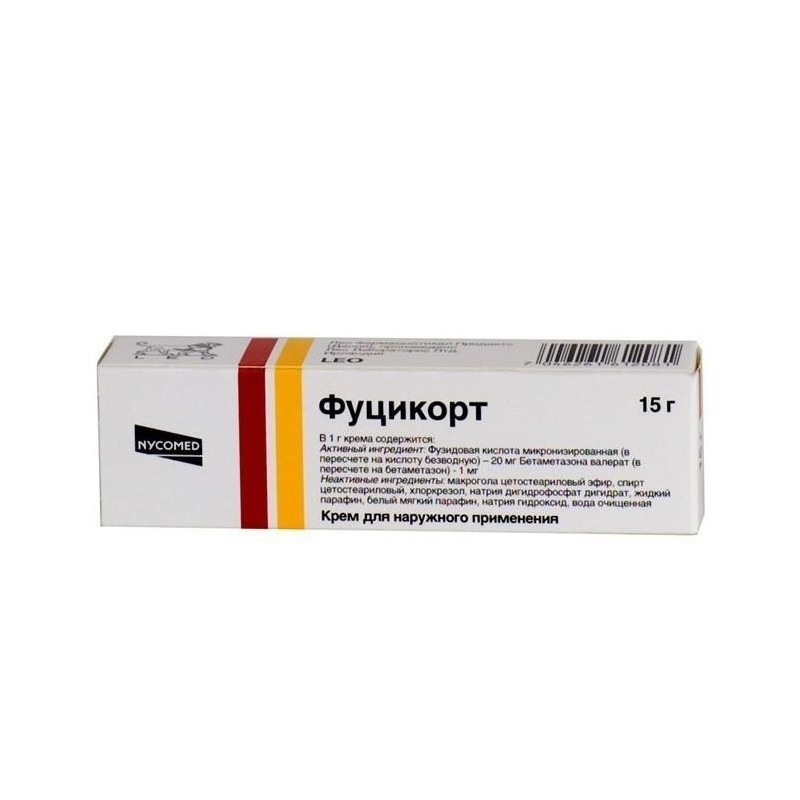



Combined preparation for external use containing antibiotic of polycyclic structure and corticosteroids.
Fusidic acid - an antibiotic of polycyclic structure. It is active mainly against gram-positive bacteria, in particular - Staphylococcm aureus, Propionibacterium acnes and corynebacteria. The mechanism of action is associated with the suppression of bacterial protein synthesis. After 30 years of use, resistance of bacteria to fusidic acid is rarely observed (1-3%). Most commonly, bacteria resistant to penicillin and other antibiotics are susceptible to fusidic acid.
Betamethasone belongs to the group of strong corticosteroids (group III) and has a pharmacological effect, suppressing local immune reactions, including vasodilation, swelling and pain.
Infectious and inflammatory skin diseases caused by microorganisms sensitive to fusidic acid:
- dermatitis;
- infected allergic eczema;
- toksidermiya.
| 1 g | |
| fuzidovoy acid hemihydrate | 20.4 mg, |
| which corresponds to the anhydrous content of fusidic acid | 20 mg |
| betamethasone valerate | 1.214 mg, |
| which corresponds to the content of betamethasone | 1 mg |
Excipients: macrogol cetostearate - 18 mg, cetostearyl alcohol (cetyl alcohol 60%, stearyl alcohol 40%) - 72 mg, chlorocresol - 1 mg, sodium dihydrogen phosphate dihydrate - 3 mg, liquid paraffin - 60 mg, soft white paraffin (contains about 10 ppm α-tocopherol) - 150 mg, sodium hydroxide - qs, purified water - up to 1 g
No customer reviews for the moment.
Apply externally.
Adults and children apply a thin layer of cream on the affected area 2-3 times / day. The course of treatment is not more than 2 weeks.
Determination of the frequency of adverse reactions: very often (> 1/10), often (> 1/100 and <1/10), infrequently (> 1/1000 and <1/100), rarely (> 1/10 000 and <1 1000="" very="" rarely="" 1="" 10="" 000="" p="">
On the part of the skin and skin appendages: rarely - a rash, exacerbation of eczema, skin irritation, skin itching, burning sensation or tingling of the skin; frequency is unknown - skin atrophy, contact dermatitis, erythema, dry skin.
Although these reactions have not been reported in clinical studies of the drug Fucicort, external use of GCS can lead to telangiectasias and striae, especially with prolonged use.
As with other GCS, folliculitis (steroid acne), hypertrichosis, perioral dermatitis, depigmentation, hemorrhagic rash, acne rosacea, prickly heat, maceration of the skin, systemic effects of GCS are possible.
Allergic reactions: frequency is unknown - urticaria.
- rosacea;
- perioral dermatitis;
- juvenile acne;
- primary bacterial, viral and fungal skin diseases;
- skin tuberculosis;
- skin manifestations of syphilis;
- children's age up to 1 year;
- Hypersensitivity to the drug.
Drug interaction of the drug Fucicort is not known.
Clinical data on the use of the drug Fucicort during pregnancy and lactation are not available.
In experimental animal studies, the teratogenic effect of fusidic acid was not observed, but was noted when using GCS.
The safety of topical use of corticosteroids during pregnancy has not been established. The use of corticosteroids during pregnancy is possible only when the expected benefit of therapy for the mother outweighs any potential risks to the fetus. In this category of patients, corticosteroids should not be used in high doses or for a long time.
Perhaps the use of the drug Fucicort during lactation only on the advice of a doctor.
GCS is excreted in breast milk, but the likelihood of their effect on an infant is very small when applied topically to a limited area of skin. If long-term treatment or use of the drug in high doses is indicated, breastfeeding should be discontinued. During lactation should not be applied cream on the mammary glands.
With caution should use the drug for perianal or genital pruritus; on large areas of the skin, under occlusive dressings, face, areas of diaper rash; in the periorbital region, since at the same time development of glaucoma is possible.
Bacterial resistance associated with the use of fusidic acid is noted.
As with other antibiotics, excessive or repeated use of the drug may increase the risk of developing antibiotic resistance.
Do not apply the drug to open wounds and mucous membranes.
If the use of Fucicort cream causes irritation or excessive sensitivity of the skin, you should stop using it and begin another appropriate treatment.
In case of discontinuation of treatment, the appearance of withdrawal syndrome may occur, manifested as redness, burning sensation or tingling of the skin or exacerbation of psoriasis. These phenomena can be prevented with the gradual withdrawal of the drug.
After long-term external treatment with potent corticosteroids, atrophic changes are most often found on the face, the external genital organs, the inner side of the upper and lower extremities, compared to other areas.
The drug contains chlorocresol, which can cause allergic reactions, as well as cetostearyl alcohol, which can cause local skin rashes (for example, contact dermatitis).
Use in Pediatrics
Due to the fact that in children, the ratio of surface area and body weight is greater than in adults, children are at greater risk of suppressing the function of the hypothalamic-pituitary-adrenal system and the development of Cushing syndrome when using any GCS for external use. Long-term treatment of children with GKS can lead to impaired growth and development of the body.
When treating children, the drug should be used in the minimum effective dose.
Influence on ability to drive motor transport and control mechanisms
The drug does not affect the ability to drive vehicles and control mechanisms.
Symptoms: due to excessive, long-term external use of GCS, it is possible to suppress the function of the pituitary and adrenal glands, which can lead to secondary (usually reversible) insufficiency of the adrenal glands.
Treatment: symptomatic therapy.